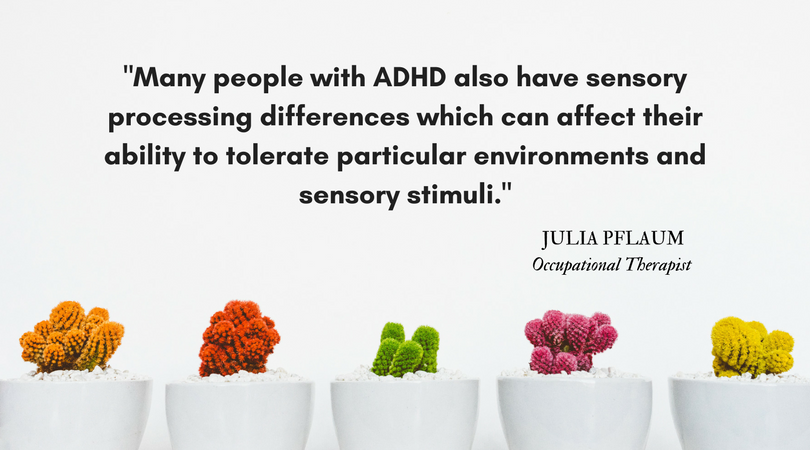I work in a clinic for adults with Attention Deficit Hyperactivity Disorder (ADHD), which is a fascinating area to work in. I started in a new Occupational Therapy role in the clinic at the beginning of the year as it expands to offer more psychosocial interventions. Adult ADHD has been established as a diagnosis only relatively recently and many of our referrals are from people who have contacted their GP after having a child diagnosed or learning about ADHD in the media and recognising similar traits in themselves.
The goals of the service users I work with vary widely from wanting techniques for remembering appointments or organising their home environment, to wanting to start their own business or manage projects in work. Many people with ADHD also have sensory processing differences which can affect their ability to tolerate particular environments and sensory stimuli.
Some people have well developed coping strategies and others are searching for approaches which will help. The clinic has a caseload of over a thousand service users and covers four different Clinical Commissioning Groups, so I am always considering where my time is best spent. Since starting work at the clinic in January 2017, I have been using these approaches:
Psychoeducation
The clinic often receives referrals for service users who are about to turn 18 and are moving from Child and Adolescent Mental Health Services and Paediatric services to Adult services. Along with our Speciality Doctor, I run a group for these 18 to 20 years olds as they move into the Adult clinic. We cover the neurological basis and potential impact of ADHD, coping strategies and evidence about the benefits of regular exercise, good sleep and healthy diet. We use a strengths based approach to identify activities they do well and consider which elements of the activity or environment help them to perform well. I am developing a similar group for adults of all ages who have recently been diagnosed with ADHD, to help with the adjustment process of acknowledging the diagnosis, developing strategies and telling family and friends.
Skills building
Many service users talk about their frustration with not being able to start or complete tasks at work, college or university and finding it difficult to keep track of time. They may often forget things or find their attention drifts during meetings or conversations. Building rewards and breaks into an activity can improve the likelihood of a person with ADHD completing the task, so I use activity analysis to identify where rewards could be added and whether social reinforcement would also act as a reward. We also look at the complexity and length of a task, their physical environment and the person’s own physical and mental state. Research about the benefits of physical activity has been particularly interesting, because some evidence indicates that exercise can reduce worrisome thoughts and decrease impulsivity among people with ADHD. Many service users find exercise useful as a way to help manage their hyperactivity and improve their motivation.
Adaptations which help with routines at home can include voice activated home assistants, which can help with prompts and reminders, or phone based calendar apps, which are frequently used by the people I work with.
Sensory Processing
There is growing evidence for people with ADHD having sensory processing difference so I use the Adult/Adolescent Sensory Profile (AASP) to assess a person’s sensory profile and discuss potential changes to their environment and routine. The AASP measures a person’s sensitivity to visual, auditory, tactile, gustatory and vestibular stimuli, to inform intervention planning. For example, a person with ADHD who is hypersensitive to auditory stimuli may benefit from an intervention as simple as sitting further away from the door of a busy office, so they are less overwhelmed by people talking in the corridor or coming in and out of the office. We work with the concept of a ‘Sensory Diet’ so that the person becomes more aware of the effects of the various stimuli they are exposed to throughout the day. For example if they have a noisy commute on the train on the way to work, they may benefit from arriving 15 minutes early and walking around somewhere quieter before starting their working day, instead of going straight into work and into another stimulating environment, which could cause affect their concentration.
Measuring outcomes
There is a body of evidence about Occupational Therapy for children with ADHD, but not as much research exists for adults with ADHD, so I aim to add to the research in this field in future along with colleagues at the clinic. I use the Model of Human Occupation tools for initial assessments and the Work and Social Adjustment Scale along with Adult/Adolescent Sensory Profile to measure the effects of sensory processing difficulties on work, home, social life, leisure activities and relationships at baseline and during later reviews. I use the WEISS Functional Impairment Rating Scale as a more detailed measure of a person’s level of performance in their home, education, work, social life, risk and sense of self. These tools provide both an overview and a more nuanced picture of a person’s balance of occupations.
Training for organisations
Myself and other colleagues have delivered teaching sessions on this developing area of practice and will be training other organisations on Adult ADHD.
There are a wide range of areas for an Occupational Therapist to address when working with adults with ADHD. It is an endlessly interesting role because the range of needs are so varied and the interaction between the person, their environment and their occupations continue to inform how I work with service users and the rest of the team.



One comment
Hi,
I have recently been diagnosed with ADHD at age 48. I have emailed Julia but had nil response: my email may have gone to the junk box.
Could I please have the name and contact details of the clinic for adults with ADHD that Julia works for?
Regards
Lisa